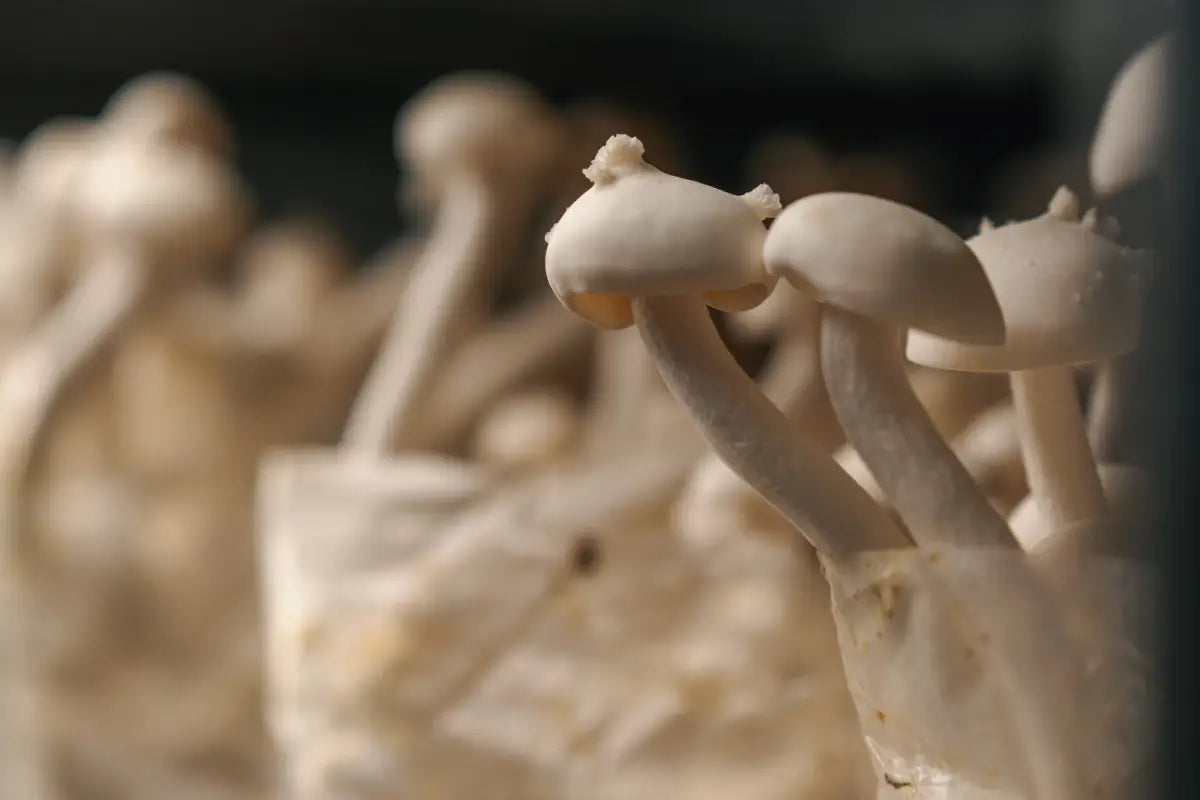
How to Set Up a Fruiting Tent (2025): Complete Guide for Maximum Mushroom Yields
Introduction: The Foundation of Successful Mushroom Cultivation
Setting up a proper fruiting tent is arguably the most critical step in successful mushroom cultivation. The fruiting stage is where all your preparation work pays off, transforming colonized substrate into beautiful, harvestable mushrooms. Whether you're growing gourmet varieties like oyster and shiitake or medicinal mushrooms like lion's mane and reishi, a well-designed fruiting environment dramatically increases your chances of success.
This comprehensive guide will walk you through every step of setting up a professional-quality fruiting tent that creates the perfect microenvironment for triggering and supporting abundant mushroom harvests. From selecting the right equipment to fine-tuning environmental conditions, we'll cover everything you need to know to create a fruiting chamber that produces consistent, high-quality results.

Choosing the Right Fruiting Tent: Size and Features
The foundation of your fruiting setup begins with selecting the appropriate tent. Unlike plants that require significant vertical space, mushrooms can thrive in more compact environments with proper organization.
Size Considerations for Different Growing Goals
- Small-Scale Growing (1-5 lbs weekly): A 2'x2.5' or 2'x4' tent provides adequate space for a modest personal mushroom operation
- Medium Production (5-15 lbs weekly): Consider a 4'x4' or 4'x8' tent with multiple shelving levels
- Commercial Scale (15+ lbs weekly): Larger 5'x9' or specialized mushroom production tents with advanced environmental controls
Critical Tent Features for Mushroom Success
Our grow tents come with easy-to-use doors and viewing windows, allowing you to check on your mushrooms without disrupting their environment. Gorilla Grow Tent When selecting a tent, prioritize these essential features:
- Material Density: 1680D canvas provides superior insulation and humidity retention
- Viewing Windows: Allow monitoring without disrupting the growing environment
- Multiple Access Points: Side and front entry options for managing different areas
- Ventilation Ports: Strategically placed for controlled fresh air exchange
- Waterproof Flooring: Prevents moisture damage and simplifies cleaning
- Reinforced Frame: Supports the weight of multiple shelving units and equipment
The Gorilla Mushroom Grow Tent collection is specifically designed for fungi cultivation with these specialized features built-in.
Essential Equipment: Creating the Perfect Fruiting Environment
Begin setup by selecting an appropriate location away from direct sunlight, temperature extremes, and high-traffic areas that might introduce contamination. Gorilla Grow Tent Once you've chosen your location, you'll need the following equipment to create optimal conditions:
Shelving System: Maximizing Your Growing Space
- Material: Food-grade plastic or stainless steel shelving (easily sanitized)
- Configuration: Adjustable height shelves to accommodate different mushroom varieties
- Spacing: 12-18" between shelves for adequate airflow
- Load Capacity: Minimum 50 lbs per shelf to support substrate blocks
Humidity Control: The Heart of Mushroom Fruiting
Maintaining humidity levels between 80-95% during fruiting stages is essential for proper mushroom development. Gorilla Grow Tent Your humidity system should include:
- Ultrasonic Humidifier: Creates fine mist without excessive heat
- Humidity Controller: Maintains precise levels within 1-2% of your target
- Hygrometer: Monitors real-time humidity conditions
- Humidity Tent/Barrier: Optional internal section for extremely humidity-sensitive species
Ventilation System: Balancing Fresh Air and Humidity
- Intake Fan: Brings in fresh air through filtered ports
- Exhaust Fan: Removes excess CO2 and maintains proper air exchange
- Circulation Fan: Creates gentle air movement within the tent
- Timer or Controller: Automates fan operation on appropriate schedules
Temperature Management: Species-Specific Requirements
- Digital Thermometer: Monitors ambient conditions
- Space Heater (optional): For winter growing or cool environments
- Cooling Solution (optional): For summer growing or warm climates

Step-by-Step Setup Process: Building Your Fruiting Chamber
Follow this sequence to assemble your fruiting tent efficiently:
Step 1: Tent Assembly and Placement
- Select a location with stable temperature (60-75°F) away from direct sunlight
- Ensure adequate electrical outlets for all equipment
- Assemble tent frame according to manufacturer instructions
- Install tent canvas, ensuring all zippers and seals are properly aligned
- Level the tent using adjustable feet if available
Step 2: Shelving Installation and Organization
- Assemble shelving units according to manufacturer specifications
- Position shelving to allow sufficient workspace and airflow
- Ensure shelves are level and stable
- Clean and sanitize all shelving surfaces with 70% isopropyl alcohol
- Consider a designated "clean" shelf for harvesting activities
Step 3: Environmental Control Equipment Installation
Ventilation: Install a small fan inside the tent to ensure proper air circulation. This helps prevent the buildup of stale air and minimizes the risk of contamination. Gorilla Grow Tent Continue with these steps:
- Position humidifier near the bottom of the tent to allow mist to rise naturally
- Install circulation fan(s) aimed at walls rather than directly at mushrooms
- Position intake and exhaust fans at opposite ends of the tent for cross-ventilation
- Mount hygrometer and thermometer at eye level for easy monitoring
- Organize and secure all electrical cords using cable management solutions
- Test all equipment individually before final configuration
Step 4: Automation and Control Systems Setup
- Program humidity controller to maintain 85-95% relative humidity
- Set ventilation timer for 4-6 air exchanges per hour (species dependent)
- Configure lighting timer for 12-hour cycles (if applicable)
- Test automated system cycles and adjust as needed
- Set up backup alarm system for critical parameter deviations (optional)
Step 5: Sterilization and Preparation for First Use
- Close all tent openings and run a complete system test for 24 hours
- Monitor temperature and humidity stability throughout the test period
- Make necessary adjustments to achieve target conditions
- Conduct final sanitization of all internal surfaces
- Allow tent to stabilize at target conditions before introducing mushroom blocks
Optimizing Conditions for Different Mushroom Varieties
Different mushroom species have unique environmental preferences. Here are optimal fruiting conditions for popular varieties:
Oyster Mushrooms (Pleurotus species)
- Humidity: 85-95%
- Temperature: 55-75°F (varies by strain)
- Fresh Air Exchange: 4-6 times per hour
- Light Requirements: Indirect light, 12 hours daily
- Special Considerations: Tolerates higher CO2 than most species
Shiitake Mushrooms (Lentinula edodes)
- Humidity: 80-90%
- Temperature: 55-70°F
- Fresh Air Exchange: 3-5 times per hour
- Light Requirements: Low indirect light
- Special Considerations: Benefits from humidity fluctuation to trigger pinning
Lion's Mane Mushrooms (Hericium erinaceus)
- Humidity: 90-95%
- Temperature: 65-70°F
- Fresh Air Exchange: 4-5 times per hour
- Light Requirements: Moderate indirect light
- Special Considerations: Extremely sensitive to dry air; may require humidity tent
King Trumpet Mushrooms (Pleurotus eryngii)
- Humidity: 85-90%
- Temperature: 60-70°F
- Fresh Air Exchange: 3-4 times per hour
- Light Requirements: Low to moderate indirect light
- Special Considerations: Prefers slightly lower humidity than other oyster varieties
Managing Your Fruiting Tent: Daily Operations
Once your fruiting tent is set up, establish a regular maintenance routine:
Daily Monitoring Tasks
- Check humidity and temperature readings
- Inspect mushroom development progress
- Look for signs of contamination or issues
- Ensure proper equipment function
- Harvest any mature mushrooms
Weekly Maintenance Procedures
- Clean and refill humidifier
- Wipe down surfaces with hydrogen peroxide solution
- Check and clean fan filters
- Adjust environmental parameters as needed
- Document growth progress and yields
Monthly Deep Cleaning Protocol
- Complete harvest of all mushrooms
- Remove all equipment and shelving
- Clean tent interior with mushroom-safe disinfectant
- Inspect and clean all ventilation ports
- Reassemble and reset environmental controls
- Allow 24 hours of operation before reintroducing new growing blocks
Troubleshooting Common Fruiting Issues
Even with the best setup, challenges can arise. Here are solutions to common problems:
Insufficient Fruiting or Pinning
- Possible Causes: Inadequate fresh air exchange, improper humidity, or temperature fluctuations
- Solutions: Increase air exchange frequency, check humidity controller calibration, stabilize temperature
Abnormal Mushroom Development
- Possible Causes: Excessive CO2, insufficient light, or nutrient issues in substrate
- Solutions: Increase ventilation, adjust lighting, review substrate preparation technique
Contamination Issues
Mushrooms are sensitive to contamination, so it's crucial to maintain a clean and sterile environment. Gorilla Grow Tent If contamination occurs:
- Immediate Action: Remove affected blocks immediately
- Prevention: Review sanitization protocols, check for air leaks, consider HEPA filtration
- System Check: Ensure equipment is clean and operating properly
Environmental Stability Problems
- Possible Causes: Equipment failure, power fluctuations, or seasonal changes
- Solutions: Install backup systems, use temperature-buffering techniques, adjust seasonal settings
Advanced Fruiting Techniques for Experienced Growers
Once you've mastered the basics, consider these advanced techniques:
Cold Shocking for Enhanced Pinning
- Temporarily reduce temperature by 10-15°F for 12-24 hours to trigger pinning
- Particularly effective for shiitake and lion's mane varieties
- Follow with return to normal temperature and slight humidity increase
Supplemental CO2 Management
- Use timed ventilation to create CO2 cycles that promote denser fruiting
- Monitor levels with a CO2 meter for precise control
- Adjust based on species-specific requirements
Light Spectrum Experimentation
You can use low-intensity fluorescent or LED lights on a 12/12 light-dark cycle to simulate natural daylight. Gorilla Grow Tent Advanced growers can:
- Test different light spectrums to optimize mushroom development
- Use programmable LED systems to simulate dawn/dusk transitions
- Create species-specific lighting protocols
Multi-Species Rotation Systems
- Organize tent zones for different species with varying requirements
- Implement rolling harvest schedules for continuous production
- Create microenvironments within the main tent using partial barriers
FAQs About Setting Up a Fruiting Tent
What's the minimum equipment needed for a basic fruiting tent?
A functional fruiting tent requires a grow tent with proper ventilation ports, shelving, a humidity source (humidifier or manual misting system), a small circulation fan, and basic monitoring tools (hygrometer and thermometer).
How much does it cost to set up a complete fruiting tent?
Budget setups start around $300-500, while professional systems with full automation can range from $800-1,500 depending on size and features.
Can I convert a plant grow tent to a mushroom fruiting tent?
Yes, but you'll need to modify the ventilation and humidity systems. Plant tents are designed for lower humidity and different light requirements than mushrooms need.
How do I prevent contamination in my fruiting tent?
Maintain strict cleanliness protocols, use filtered air intake, regularly sanitize all surfaces, and always handle substrates with clean hands or gloves. Consider using a HEPA air purifier in high-contamination risk environments.
What's the difference between a colonization chamber and a fruiting tent?
Colonization chambers maintain higher temperatures (70-75°F), minimal fresh air exchange, and darkness to promote mycelium growth. Fruiting tents provide more fresh air, light exposure, and often slightly cooler temperatures to trigger and support mushroom formation.
Summary: Your Path to Mushroom Growing Success
Setting up a proper fruiting tent creates the foundation for successful mushroom cultivation. By carefully controlling humidity, temperature, fresh air exchange, and light, you create the ideal environment for transforming colonized substrates into beautiful, harvestable mushrooms.
The key to success lies in understanding the specific needs of your chosen mushroom varieties and creating a consistent environment that mimics their natural fruiting conditions. With proper setup and maintenance, your fruiting tent will become a reliable production system that yields delicious, healthy mushrooms year-round.
Your Next Step: Start Growing with Confidence
Ready to start your mushroom growing journey? Gorilla Grow Tent offers specialized mushroom cultivation tents with all the features you need for successful fruiting. Our tents are designed specifically for the high-humidity, controlled-air environment that mushrooms require, with durable materials that stand up to the challenges of fungiculture.
Visit our online store to explore our complete range of mushroom growing equipment, from specialized tents to comprehensive growing kits designed to help you achieve professional-quality results at home.

Lena Myles
I'm a mushroom enthusiast and home cook based in Oregon. I'm passionate about foraging and creating fungi-focused recipes, especially delicious, plant-based dishes using gourmet mushrooms like trumpet, shiitake, and oyster. When I’m not in the kitchen, you’ll usually find me wandering the woods in search of new wild flavors.


